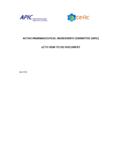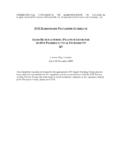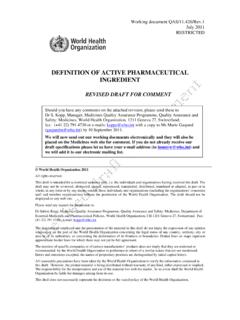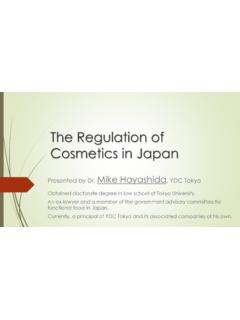Transcription of STABILITY TESTING OF ACTIVE PHARMACEUTICAL …
1 Working document January 2017. Draft document for comment 1 STABILITY TESTING OF ACTIVE . 2 PHARMACEUTICAL ingredients AND. 3 finished PHARMACEUTICAL PRODUCTS. 4 (January 2017). 5 DRAFT FOR COMMENT. Should you have any comments on the attached text and the STABILITY conditions for WHO Member States (MS) by Region, appendixed to the previous version of this guidance ( ), please send these to: Dr Sabine Kopp, Group Lead, Medicines Quality Assurance, Technologies Standards and Norms, World Health Organization, 1211 Geneva 27, Switzerland; email: fax: (+41 22) 791 4730;. and to Mrs Ksenia Finnerty by 15 March 2017. In line with the recommendations of the WHO Expert Committee on Specifications for PHARMACEUTICAL Preparations the list of MS STABILITY conditions is maintained as a living document. Comments received after the indicated date will also be considered. Working documents are sent out electronically and they will also be placed on the Medicines website for comment.
2 If you do not already receive directly our draft guidelines please let us have your email address (to and we will add it to our electronic mailing list. 6. 7 World Health Organization 2017. 8 All rights reserved. 9 . is intended for a restricted audience only, the individuals and organizations having received this draft. This draft 10 The draft may not be reviewed, abstracted, quoted, reproduced, transmitted, distributed, translated or adapted, in 11 part or in whole, in any form or by any means outside these individuals and organizations (including the 12 organizations' concerned staff and member organizations) without the permission of the World Health Organization. 13 The draft should not be displayed on any website. 14 Please send any request for permission to: 15 Dr Sabine Kopp, Group Lead, Medicines Quality Assurance, Technologies Standards and Norms, Department of 16 Essential Medicines and Health Products, World Health Organization, CH-1211 Geneva 27, Switzerland.)
3 17 Fax: (41-22) 791 4730; email: 18 The designations employed and the presentation of the material in this draft do not imply the expression of any 19 opinion whatsoever on the part of the World Health Organization concerning the legal status of any country, 20 territory, city or area or of its authorities, or concerning the delimitation of its frontiers or boundaries. Dotted lines 21 on maps represent approximate border lines for which there may not yet be full agreement. 22 The mention of specific companies or of certain manufacturers' products does not imply that they are endorsed or 23 recommended by the World Health Organization in preference to others of a similar nature that are not mentioned. 24 Errors and omissions excepted, the names of proprietary products are distinguished by initial capital letters. 25 All reasonable precautions have been taken by the World Health Organization to verify the information contained in 26 this draft. However, the printed material is being distributed without warranty of any kind, either expressed or 27 implied.
4 The responsibility for the interpretation and use of the material lies with the reader. In no event shall the 28 World Health Organization be liable for damages arising from its use. 29 This draft does not necessarily represent the decisions or the stated policy of the World Health Organization. Working document page 2. 30 SCHEDULE FOR THE PROPOSED ADOPTION PROCESS OF DOCUMENT. 31 : 32 STABILITY TESTING OF ACTIVE PHARMACEUTICAL ingredients . 33 AND finished PHARMACEUTICAL PRODUCTS. 34. Development of the proposal to update the guideline for June 2016. STABILITY TESTING of ACTIVE PHARMACEUTICAL ingredients and finished PHARMACEUTICAL products (TRS 953, Annex 2, 2009). Presentation of the proposal to the joint meeting on July 2016. regulatory guidance for multisource products with the medicines quality assurance group and the WHO. Prequalification Team Medicines (PQTm) and with regulatory experts Presentation of the proposal to the fifty-first meeting of October 2016.
5 The WHO Expert Committee on Specifications for PHARMACEUTICAL Preparations (ECSPP). Development of the draft guideline and preparation of September . December 2016. revised text by Mrs Lynda Paleshnuik, Canada Mailing and posting of the working document on the January 2017. WHO website for public consultation as recommended by the WHO ECSPP. Compilation of comments received April 2017. Discussion of feedback received during an informal Date tbd consultation Circulation for comments August 2017. Compilation of comments received September 2017. Presentation to fifty-second meeting of the WHO ECSPP October 2017. Further follow-up action as required . 35. Working document page 3. 36 Introduction and background 37. 38 The STABILITY TESTING of ACTIVE PHARMACEUTICAL ingredients and finished 39 PHARMACEUTICAL products was published as Annex 2 in the WHO Technical 40 Report Series, No. 953, 2009 (1). 41. 42 These regulatory guidelines seek to exemplify the core STABILITY data package 43 required for registration of ACTIVE PHARMACEUTICAL ingredients (APIs) and finished 44 PHARMACEUTICAL products (FPPs), replacing the previous WHO guidelines in this 45 area.
6 The guidelines cross-reference to the series of related International Council 46 on Harmonisation (ICH) guidelines (2) and other WHO guidelines. 47. 48 It was recommended at the time of publication that these guidelines should also 49 be applied to products that are already being marketed, with allowance for an 50 appropriate transition period, upon re-registration or upon re-evaluation. 51. 52 The 2009 update not only followed the usual consultation process, but it was 53 also the result of numerous interactions and discussions with the various 54 regulatory fora, including ICH. As a result the ICH parties withdrew at the time 55 one of their guidance texts (Q1F) and published the following on their website: 56. 57 Explanatory Note on the Withdrawal of ICH Q1F for the ICH Website 58. 59 ICH Q1 F STABILITY Data Package for Registration Applications in Climatic 60 Zones III and IV defined storage conditions for STABILITY TESTING in countries 61 located in Climatic Zones III (hot and dry) and IV (hot and humid), countries 62 not located in the ICH regions and not covered by ICH Q1 A (R2) STABILITY 63 TESTING for New Drug Substances and Drug Products.
7 ICH Q1 F described 64 harmonised global STABILITY TESTING requirements in order to facilitate access to 65 medicines by reducing the number of different storage conditions. In the course 66 of the discussions which led to the development of the guideline, WHO. 67 conducted a survey amongst their member states to find consensus on 30 C/65%. 68 RH as the long-term storage conditions for hot and humid regions. As no 69 significant objections were raised in this survey, 30 C/65% RH was defined as 70 the long-term storage condition for Climatic Zone III/IV countries in ICH Q1F. 71 The document was adopted by the ICH Steering Committee in February 2003. 72 and subsequently implemented in the ICH regions. 73 However, based on new calculations and discussions, some countries in 74 Climatic Zone IV have expressed their wish to include a larger safety margin for 75 medicinal products to be marketed in their region than foreseen in ICH Q1F. As 76 a consequence, several countries and regions have revised their own STABILITY 77 TESTING guidelines, defining up to 30 C/75% RH as the long-term storage Working document page 4.
8 78 conditions for hot and humid regions. Due to this divergence in global STABILITY 79 TESTING requirements, the ICH Steering Committee has decided to withdraw ICH. 80 Q1F and to leave definition of storage conditions in Climatic Zones III and IV to 81 the respective regions and WHO [web link to the WHO guidelines](1). 82. 83 In assessing the impact of the withdrawal of ICH Q1F on intermediate TESTING 84 conditions defined in ICH Q1A (R2), the decision was reached to retain 85 30 C/65%RH. However, regulatory authorities in the ICH regions have agreed 86 that the use of more stringent humidity conditions such as 30 C/75% RH will be 87 acceptable should the applicant decide to use them.. 88. 89 90 y/Q1 91. 92 Based on recent developments an analysis was commissioned to evaluate 93 whether these guidelines would need to be updated. 94. 95 During the Joint meeting on regulatory guidance for multisource products with 96 the medicines quality assurance group and the prequalification of medicines 97 team assessment group held in Copenhagen on 8 9 July 2016, this analysis 98 report was discussed in detail and feedback provided by the participants to the 99 report as well as the various sections of the current guidelines.
9 In conclusion, the 100 participants agreed that a revision of this text would be timely. 101. Working document page 5. 102 STABILITY TESTING of ACTIVE PHARMACEUTICAL ingredients and 103 finished PHARMACEUTICAL products 104 1. Introduction 105 Objectives of these guidelines 106 Scope of these guidelines 107 General principles 108 2. Guidelines 109 ACTIVE PHARMACEUTICAL ingredient 110 General 111 Stress TESTING 112 Selection of batches 113 Container closure system 114 Specification 115 TESTING frequency 116 Storage conditions 117 STABILITY commitments 118 Evaluation 119 Statements and labelling 120 Ongoing STABILITY studies 121 finished PHARMACEUTICAL product 122 General 123 Stress TESTING 124 Selection of batches 125 Container closure system 126 Specification 127 TESTING frequency 128 Storage conditions 129 STABILITY commitments 130 Evaluation 131 Statements and labelling 132 In-use and hold-time STABILITY 133 Variations 134 Ongoing STABILITY studies 135 3. Glossary 136 References 137 Appendix 1.
10 Examples of TESTING parameters 138 Appendix 2. Recommended labelling statements 139 Appendix 3. Interpretation of storage statements for products approved in zone 140 II when the products are to be distributed in zone IV. Working document page 6. 141 1. Introduction 142 Objectives of these guidelines 143 These guidelines seek to exemplify the core STABILITY data package 144 required for registration of ACTIVE PHARMACEUTICAL ingredients (APIs) and 145 finished PHARMACEUTICAL products (FPPs), replacing the previous WHO. 146 guidelines in this area (1). However, alternative approaches can be used 147 when they are scientifically justified. Further guidance can be found in 148 International Council on Harmonisation (ICH) guidelines (2), in the 149 WHO guidelines on the ACTIVE PHARMACEUTICAL ingredient master file 150 procedure (3), the WHO Guidelines on submission of documentation for 151 a multisource (generic) finished PHARMACEUTICAL product : quality part (4).














